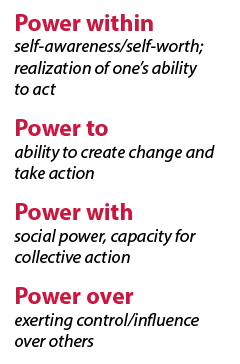International Women’s Day 2020: Measuring Gender-related Power

Five years since world leaders agreed to the Sustainable Development Goals (SDGs) to create a better world by 2030, this year’s theme for International Women’s Day, I am Generation Equality: Realizing Women’s Rights, challenges everyone to reflect on how a gender-equal world will be achieved. DHS data describe the status of women around the world. Over time, women have made gains in education, employment, health care, and family life. However, progress towards gender equality is halting and inconsistent.

In a gender-equal world, women and men will have equal power: the power within to know their right to equality, the power to create change, and the power with others. In a gender-equal world, other people’s power over women will be reduced, especially the most extreme expression of power over, gender-based violence (GBV).
DHS questionnaires already give insight into the types of power that women and men do and do not have. For instance, a composite scale of three DHS survey items is used to measure progress toward SDG Indicator 5.6.1: the proportion of women age 15-49 who make their own informed decisions regarding sexual relations, contraceptive use, and reproductive health care.
DHS data have been used to construct other composite scales, such as the Survey-based Women’s emPowERment (SWPER) index to measure women’s empowerment. The Population Council’s Gender and Power Metrics database includes several scales that use DHS data to measure gender, agency, power, and control.
The DHS Program has recently updated DHS-8 questionnaires and optional modules, including the Domestic Violence module, to fill gender-related data gaps and respond to emerging gender data needs. For instance, in several countries around the world, many people live together in unions that have not been officially registered. A registered marriage is related to a range of social protections and rights, such as divorce and inheritance, that are especially important for gender equality. New questions have been added to the Woman’s Questionnaire on marriage registration:
- Did you have a marriage certificate for your last marriage?
- Do you have a marriage certificate for this marriage?
- Was this marriage ever registered with the civil authority?
Measuring gender-related power using DHS data highlights countries’ progress towards gender equality, especially in the areas of reproductive empowerment, male engagement, and reduction of GBV. Measuring power can also help program managers and policymakers understand how power manifests within couples, between service providers and clients, and how different interventions can cultivate positive expressions of power and mitigate harmful expressions of power over for a more equal world.
For International Women’s Day 2020, explore gender-related power measures in DHS surveys in an inventory and a presentation. You can also explore many common gender indicators using The DHS Program’s Gender mini tool.
Featured image caption: © Mary Long

